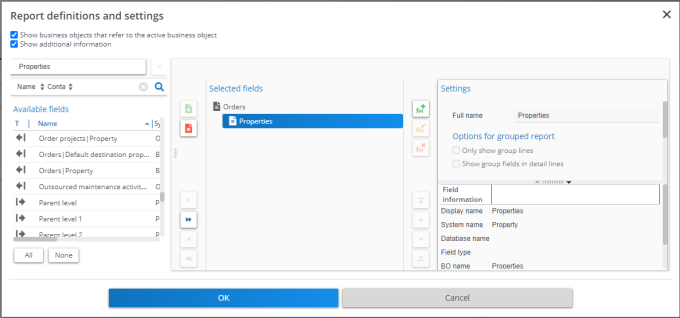Including sub reports in your report definition
It may be that the business object for which you want to create a report definition is linked to another business object. The data of the linked business object can also be included in the report. If a report on a specific business object contains a subsection with data from another business object, this is called a subreport.
For example: orders are linked to a property. You could make a report on properties, including a subreport with orders per property.
Procedure
1. Open the TSI and selection level or step corresponding to the subject of the report, for example the Properties selection level of the Work Orders TSI if you want to create a report with properties, including a subreport on orders for each property.
2. From the Report action menu, select the Report option.
The Reporting window opens.
3. Click Add.
The Report definitions and settings window opens. In this window you can select the fields you want to include in your report definition.
By using the horizontal and vertical sliders in this window, you can customize the panels' size as required. |
For more information on including 'normal' fields, refer to To add a new user report definition.
For subreports, you can use either association fields or reference fields. For more information on these field types, refer to Field types.

4. Select the association (or reference) field you want to include in your subreport, for example the Orders|Property field if you want to include a subreport with orders for each property.
5. Click Add subreport  , to add a subreport.
, to add a subreport.
 , to add a subreport.
, to add a subreport.In a report definition, it is possible to define subreports down to a maximum of 10 levels. |
A subreport is added to your definition. In the Settings section of the window, you can make some settings for the subreport, such as font type and background color.
For more information on this subject, refer to Making report settings.
From the Available fields section, select the fields you want to include in your subreport, for example Number and Description, and move them to the Selected fields section.
6. Make the required field settings for the selected fields, such as column width or alignment.
For more information on field settings, refer to Making field settings.
7. Click OK to save your report definition.
8. To save the report in the required output format, click Save as.
For more information on Save as settings, see Save options for reports. |
It is possible to copy a user report so that you can reuse and configure it.